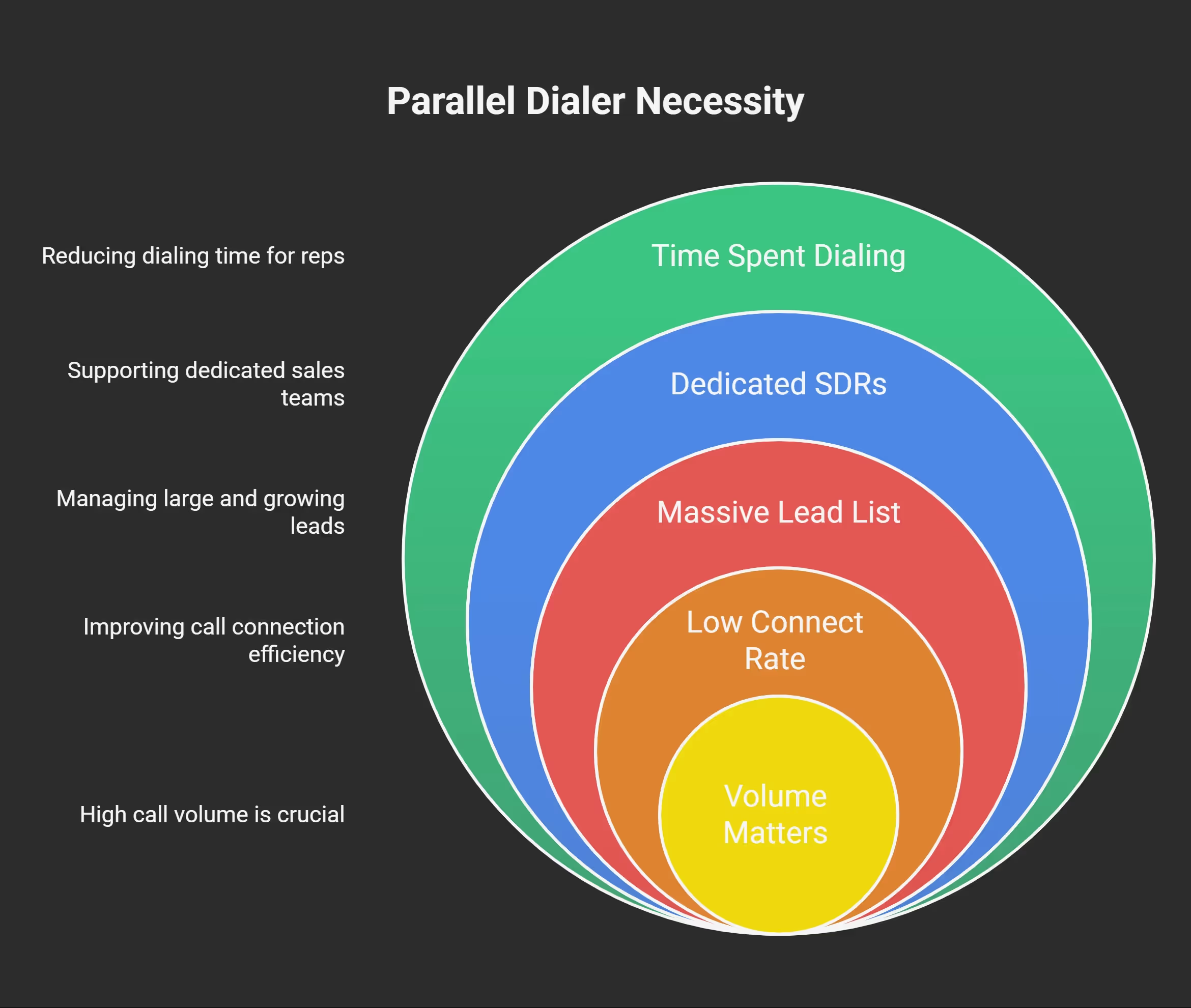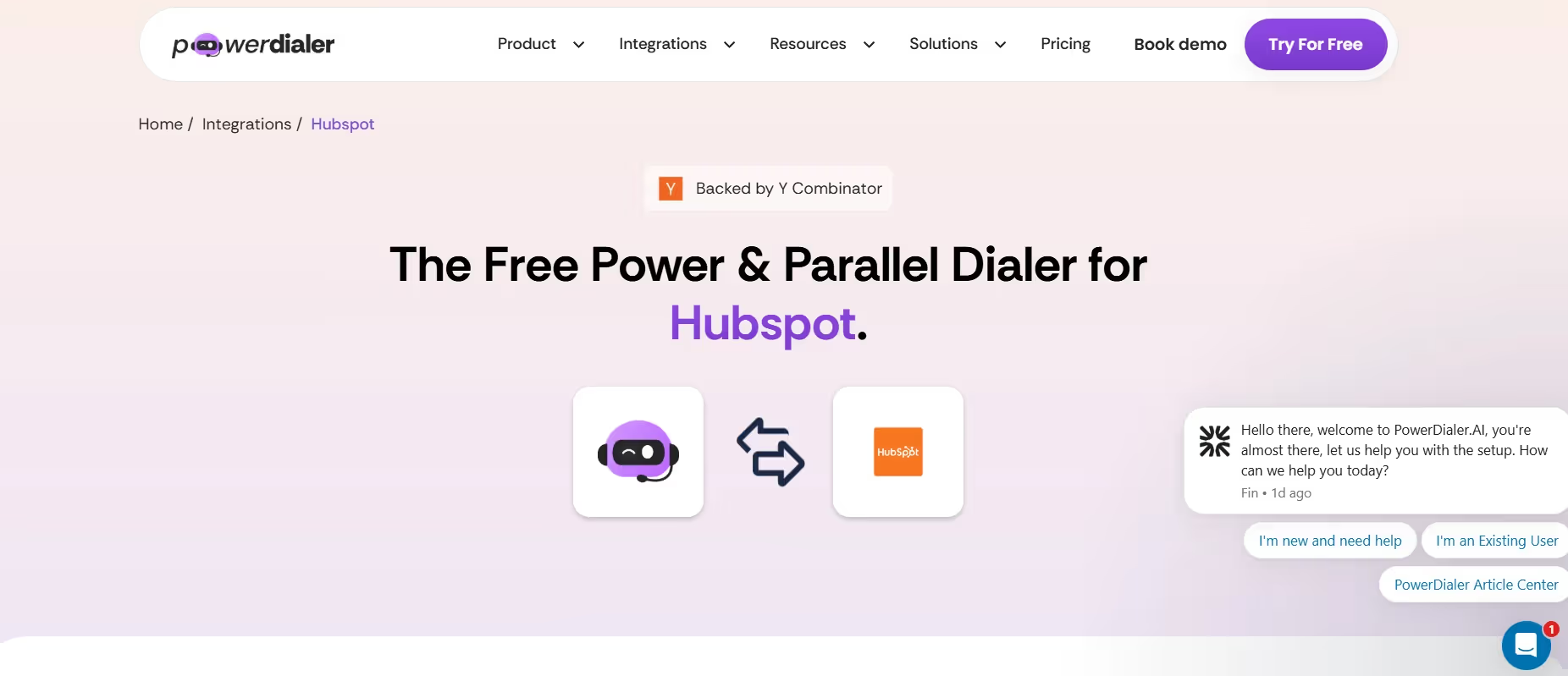
Top 5 Parallel Dialers for 2025 That Will Transform Your Sales
Summary
In today’s competitive sales landscape, every second counts. This blog explores how parallel dialers are helping modern sales teams boost productivity by cutting down on wait time and increasing live conversations. You’ll learn what a parallel dialer is, how it compares to other dialing methods, and why it’s becoming a must-have tool in 2025.
The post also breaks down the top 5 parallel dialers on the market, Orum, Nooks.AI, PowerDialer.ai, Klenty, and JustCall, highlighting their key features, best use cases, pros, and cons. Whether you’re a startup or managing a large outbound team, this guide will help you find the right solution to supercharge your outreach.

Let’s be real, deals are a race against time. Whether you are chasing prospects or trying to keep up with inbound leads, every minute your reps spend dialing is time they’re not dealing. In 2025, that’s just not good enough. That’s why further and further brigades are turning to relevant dialers. These tools aren’t just about telephoning briskly, they’re about changing the way your platoon connects with prospects.
They cut out the dead time, help you get in front of further real exchanges, and give your platoon the tools they need to hit( and exceed) their figures. So what exactly is a resemblant dialer? Why is it suddenly ar and wide? And if you’re considering using one, how do you choose the right one for your business? Let’s break it all down, and I’ll also partake in 5 of the stylish resemblant dialers to check out in 2025.
What Is a Parallel Dialer and How Does It Work?

Here’s the truth: not every sales team needs a parallel dialer. If you’re doing a handful of personalized calls a day, this probably isn’t for you. But if any of the following sound familiar, it’s time to take a serious look:
- Your reps spend more time dialing than talking.
- Your lead list is massive and growing.
- You have dedicated SDRs or outbound reps.
- Your connect rate is low.
- You’re looking to scale without hiring a dozen more people.
Whether you're a SaaS company, a real estate brokerage, or a solar sales team, if volume matters, a parallel dialer could easily be your secret weapon.
Why Parallel Dialer Software Is a Game-Changer in 2025
Sales teams today juggle two major challenges:
- Speed vs. Efficiency – Making more calls without burning out your team.
- Smart Selling – Real-time insights that guide rather than overwhelm.
Here’s how parallel dialers tackle both:
- Saves Hours Every Week
Reps used to waste more than an hour waiting for calls. Now, they spend that time talking, boosting connection rates by up to 300%. - Smarter Voicemail Handling & Compliance
Most tools automatically skip voicemails or drop personalized messages. Plus, they help with TCPA and DNC list compliance. - Seamless CRM Sync & Real-Time Dashboards
Leads, call notes, and transcriptions auto-log into your CRM. No more manual updates or training sessions. - Built for Collaboration & Coaching
Some platforms offer virtual sales floors where managers can listen, coach, and engage with reps live. - Remote-Ready & Scalable
All you need is a browser. Whether your team is in-house, hybrid, or remote, everyone can stay dialing without IT headaches.
In short, parallel dialer software gives you the speed of today and the insights to dominate tomorrow.
How to Pick the Best Parallel Dialer for Your Team
Top 5 Parallel Dialers for 2025 – Reviewed & Compared
Choosing the right parallel dialer can dramatically impact your team’s call efficiency, talk time, and even morale. Below are five of the top-performing tools in 2025, based on real-world use, features, and flexibility.
1. Orum
Orum is a powerful parallel dialer built for sales teams that want to scale conversations fast. It combines speed dialing with intelligent routing, live coaching tools, and virtual salesfloor features that are especially useful for remote or hybrid teams.
Best For: Enterprise or fast-growing sales teams looking for high productivity, team collaboration, and manager-friendly oversight.
Key Features:
- Parallel dialing with AI call detection
- Virtual salesfloor (see who’s calling in real time)
- Live coaching and call monitoring
- CRM integrations (Salesforce, HubSpot, etc.)
- Real-time analytics and performance dashboards
Pros:
- Built for team collaboration
- Great coaching tools for managers
- Strong enterprise-level analytics
Cons:
- Pricing is custom and may be expensive
- Requires some onboarding and rep training
2. Nooks.AI
Nooks is a high-performance AI-powered dialer designed for teams that want precision and results. It blends parallel dialing with sales intelligence, call scoring, and smart workflows that make every session count.
Best For: Performance-heavy SDR teams or sales orgs focused on speed, personalization, and analytics.
Key Features:
- Parallel and power dialing with AI optimization
- Sales coaching and call scoring
- Smart task routing and lead prioritization
- Live team dashboards and virtual coaching zones
- CRM and Slack integrations
Pros:
- Extremely data-driven and customizable
- Excellent for coaching and sales enablement
- Helps with prioritizing high-value prospects
Cons:
- Premium pricing ($300+/user/month)
- Best suited for larger, aggressive teams
3. PowerDialer.ai

PowerDialer.ai is a user-friendly and AI-powered parallel dialer that focuses on increasing rep productivity without overwhelming the team. It’s great for small to mid-sized sales teams that want fast setup, clear insights, and solid core features at an affordable price point.
Best For: Startups, remote teams, or growing companies looking for efficient, affordable outbound calling.
Key Features:
- Parallel and power dialing options
- Live call transcription and recordings
- AI-powered voicemail detection
- Custom voicemail drops
- CRM auto-syncing and call analytics
Pros:
- Easy to set up and onboard
- Clean, intuitive interface
- Offers a free plan (ideal for testing)
- Saves reps 10+ hours per week
Cons:
- May lack some advanced coaching features
- Analytics are solid but not as deep as enterprise tools
4. Klenty
Klenty is a sales engagement platform that includes a built-in parallel dialer, alongside tools for email outreach, cadences, personalization, and automation. It’s ideal for sales teams that want to run full multichannel campaigns from a single dashboard.
Best For: Account-based sales teams or B2B SDRs using a multichannel approach (calls + email + LinkedIn).
Key Features:
- Parallel dialer with voicemail skip
- Email sequences and personalization
- Power dialing and task automation
- CRM integrations with deal syncing
- Account-based engagement and tagging
Pros:
- Excellent for multichannel outbound
- Great lead and sequence management
- Easy to scale with growing teams
Cons:
- Can feel complex for call-only use cases
- No transparent pricing on the website
5. JustCall
JustCall is a full-featured communication platform offering calling, texting, email, and WhatsApp, all under one roof. Its parallel dialer is part of a larger system aimed at helping sales and support teams manage everything from prospecting to support calls.
Best For: SMBs and support/sales teams looking for a unified communication platform with flexible dialers.
Key Features:
- Parallel, power, and predictive dialing
- AI Agent Assist (real-time suggestions)
- Text, email, and WhatsApp integration
- 100+ CRM and app integrations
- Call routing and IVR options
Pros:
- Strong all-in-one communication suite
- Flexible use across departments (sales + support)
- Works well for global teams
Cons:
- The interface can feel cluttered
- Best features require higher-tier plans
- Less specialized focus on outbound sales
Quick Comparison Table
Parallel Dialer vs. Other Dialing Methods
It’s worth seeing how parallel dialers compare to other options:
- Parallel Dialer: Multiple calls dialled at once, connected instantly. Best for conversation-heavy teams.
- Power Dialer: Calls one immediately after another. Easy but sequential.
- Predictive Dialer: Uses agent availability algorithms, common in big call centers.
- Progressive Dialer: Calls when agents are ready, prioritizes lead quality over speed.
- Preview Dialer: Displays lead info before dialing, good for extra prep.
Parallel dialers balance speed and agent productivity, no guesswork, just conversations.
How to Launch a Parallel Dialer Rollout
- Set clear goals (e.g., +20% connect rate or +2 hours talk time daily).
- Pilot with a small team, track performance against your current baseline.
- Monitor real metrics, not just call volume.
- Clean your contact lists before dialing.
- Train reps on new workflows; they’ll adapt fast with good scripts.
- Coach with call recordings and dashboards.
- Experiment with pace, don’t burn out your team just to go faster.
- Expand slowly, if the pilot shows gains, scale across teams.
Wrapping It Up
In 2025, your dialing strategy can’t just be fast; it has to be smart. Parallel dialer software levels up your ability to connect, coach, and convert, without burning out your team.
- If you want simplicity and speed, go with PowerDialer.ai.
- For enterprise coaching and control, try Orum or Nooks.AI.
- If multichannel outreach is your game, Klenty steps in.
- And if you need a full-suite communication solution, JustCall is hard to beat.
Consider a pilot, measure your wins, and then scale. The right tool not only boosts numbers, it changes how your team feels, works, and wins.
Ready to boost your team’s connect rate? Try a parallel dialer and start turning more calls into conversations today.
FAQs
Q: Do parallel dialers automatically handle voicemails?
Yes, most platforms detect voicemail and drop pre-recorded messages or filter them out.
Q: Are they compliant with telemarketing laws?
Yes, robust tools include DNC filtering and TCPA support, but always verify settings before dialing.
Q: Which tool suits beginners?
PowerDialer.ai wins for ease, followed by Klenty for integrated campaign use.
Q: Do I need advanced training?
With tools like Orum or Nooks.AI, yes. But PowerDialer.ai or JustCall takes less ramp-up time.
Q: How to measure if it's worth the change?
Track talk time, connect rates, conversion rates, and rep fatigue. Compare pre- and post-deployment metrics.
